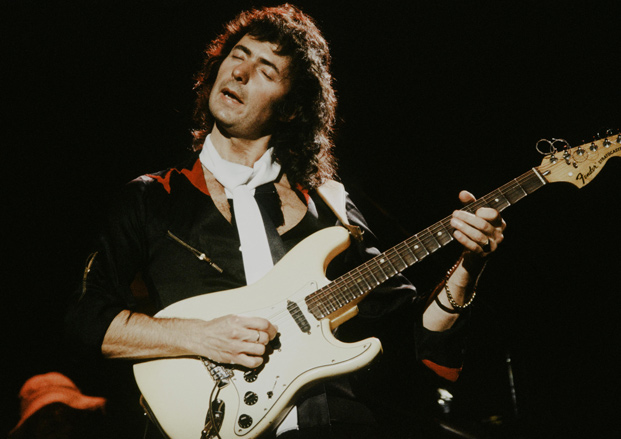Ritchie Blackmore Talks "Highway Star"; Covers by Steve Vai, John Petrucci, Joe Satriani and More

The bulk of this story is from the Guitar World archives, from our "100 Greatest Guitar Solos of All Time" series. Enjoy!
“Highway Star” is but one highlight of Machine Head, Deep Purple’s greatest triumph.
Ironically, it almost never came to be. In early 1972, shortly after retreating to Montreaux, Switzerland, to record, the British band was beset by a wealth of problems. "First, the place they were staying, which overlooked Lake Geneva, burned down—inspiring them to write “Smoke on the Water.”
Then, in response to a complaint about excessive noise, the police kicked the band out of the ballroom where they were recording. “We were stuck in Switzerland with nowhere to go, and a friend of ours who was the mayor of the town said that there was an empty hotel we could use,” recalls guitarist Ritchie Blackmore.
“We gladly accepted and retreated to this lonely hotel in the mountains. We set up all the equipment in the corridor, with the drums and some amps tucked into alcoves. “We had the Rolling Stones’ mobile recording unit sitting outside in the snow, but to get there we had to run cable through two doors in the corridor into a room, through a bathroom and into another room, from which it went across a bed and out the veranda window, then ran along the balcony for about 100 feet and came back in through another bedroom window.
"It then went through that room’s bathroom and into another corridor, then all the way down a marble staircase to the foyer reception area of the hotel, out the front door, across the courtyard and up the steps into the back of the mobile unit. I think that setup led to capturing some spontaneity, because once we got to the truck for a playback, even if we didn’t think it was a perfect take, we’d go, ‘Yeah, that’s good enough.’
Because we just couldn’t stand going back again.” But while the vibe may have been loose, Blackmore’s solo on ‘Highway Star’ was well planned. “I wrote that out note for note about a week before we recorded it,” says the guitarist.
Get The Pick Newsletter
All the latest guitar news, interviews, lessons, reviews, deals and more, direct to your inbox!
“And that is one of the only times I have ever done that. I wanted it to sound like someone driving in a fast car, for it to be one of those songs you would listen to while speeding. And I wanted a very definite Bach sound, which is why I wrote it out—and why I played those very rigid arpeggios across that very familiar Bach progression—Dm, Gm, Cmaj, Amaj. I believe that I was the first person to do that so obviously on the guitar, and I believe that that’s why it stood out and why people have enjoyed it so much.
“[Keyboardist] Jon Lord worked his part out to mine. Initially, I was going to play my solo over the chords he had planned out. But I couldn’t get off on them, so I made up my own chords and we left the spot for him to write a melody. The keyboard solo is quite a bit more difficult than mine because of all those 16th notes.
- "Over the years, I’ve always played that solo note for note—again, one of the few where I’ve done that—but it just got faster and faster onstage because we would drink more and more whiskey. Jon would have to play his already difficult part faster and faster and he would get very annoyed about it.”
Deep Purple (with Ritchie Blackmore) perform "Highway Star" in 1972:
Generation Axe play "Highway Star" in 2016:
Steve Vai, Glenn Hughes and Chad Smith play "Highway Star" in 2012:
Chickenfoot (with Joe Satriani) perform "Highway Star":
Street musician Damian Salazar plays "Highway Star":
Deep Purple (with Steve Morse) perform "Highway Star" in 2011:
Dream Theater perform "Highway Star":
Deep Purple, "Highway Star" isolated guitar track (studio version):
Since 1980, Guitar World has been the ultimate resource for guitarists. Whether you want to learn the techniques employed by your guitar heroes, read about their latest projects or simply need to know which guitar is the right one to buy, Guitar World is the place to look.
“Such a rare piece”: Dave Navarro has chosen the guitar he’s using to record his first post-Jane’s Addiction material – and it’s a historic build
“The best guitar player I ever heard”: Nashville guitar extraordinaire Mac Gayden – who worked with Bob Dylan, Elvis, Linda Ronstadt and Simon & Garfunkel – dies at 83





![[from left] George Harrison with his Gretsch Country Gentleman, Norman Harris of Norman's Rare Guitars holds a gold-top Les Paul, John Fogerty with his legendary 1969 Rickenbacker](https://cdn.mos.cms.futurecdn.net/TuH3nuhn9etqjdn5sy4ntW.jpg)





